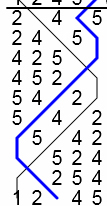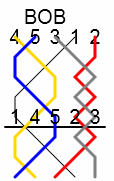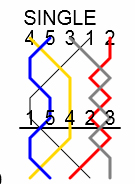Learning Methods - Grandsire Doubles.
After many years of teaching ringing in various different ways, I have come to the conclusion that what follows here is the best way of all, because if you start off this way, learning the more complicated methods will be much easier for you when you get to that stage. Give it a try, and if you really find it doesn't suit you, then there are plenty of other ways of progressing.
Before you start on a Method, you must be able to hunt the Treble reliably, knowing where you are all the time, and finding the bells to follow. You will probably be given the oppotunity to ring the 2nd to Grandsire as well, as that is Plain Hunting too.
Grandsire is an easy method to start with, as there are only three pieces of work to learn. You have probably been told to learn the "Blue Line". (That's if you've been told anything! Ringers are notorious for expecting learners to pick things up out of thin air, with no help at all other than a bit of yelling, "You've missed your dodge!" or "Lead!"). You do need to learn the Blue Line, but not all in one piece.
Learn it in three separate chunks. It divides up each time the treble is striking it's Backstroke Lead, as below:

As you can see, the Blue Line here shows the work of bell number 3. This work is known as "3rd's Place Bell".
The 3 starts it's work by ringing one more blow in 3rd's place. (It has already been ringing in 3rd's place in Rounds of course.) Then it hunts down to lead, and after it's led it hunts up to 5th's place where it stays for two blows. Now it rings one blow in 4th's, and then becomes 4th's Place Bell.

Here is 4th's Place Bell. You can see how it joins nicely onto 3rd's Place Bell.
4th's Place Bell nips up to ring one blow in 5th's, then hunts down to lead and back up to ring another single blow in 5th's. Now it becomes 5th's Place Bell.

5th's Place Bell starts with a blow in 4th's, then two blows in 5th's.Then it hunts down to lead, starts to hunt back towards the back, but it finishes in 3rd's, and here you will see that we have arrived back at Rounds. If the Conductor does not call "That's All", you just start again. As you have finished in 3rd's place, you are 3rd's Place Bell again.
Moving on to Touches
After ringing plain courses for a while, you will be keen to get to grips with the Bobs and Singles. These calls have the effect of swapping the bells around, so that the person ringing the 2 gets a chance to do something more interesting than Plain Hunting. One of the other bells becomes "The Hunt Bell" instead. Of course, the real reason for having calls is to make the ringing last longer than a plain course, which is over very quickly.
At A Bob......

- If you have just rung 5th's Place Bell, and are expecting to become 3rd's Place Bell, a Bob is very easy. You are unaffected! Look at the BLUE line above. The only difference is that the bells you ring after will come to you in a slightly different order.Whether you are ringing by Ropesight or by Places (or a bit of both as most of us do), you should have no problem making thirds and setting off on 3rd's Place Bell's work.
- If you have been happily Hunting along being 2nd's Place Bell, you must wake up now and do a bit of real work. What you are going to do is called a "Double Dodge Down". But the best way to look at it is like this: The Bob will have been called while you are at the back, ringing your two blows in 5th's place. Grandsire calls are called at Handstroke, so it will actually be while you are ringing the second blow in 5th's. You ring your blow in 4th's that you were going to do anyway, but then hold up and ring one blow ( a point blow) in 5th's, and then another single blow in 4th's place. Now at this point the Treble is Leading at backstroke, and this is where you become 4th's Place Bell. As you know by now, 4th's Place Bell starts by holding up and ringing a point blow in 5th's. So if you look at the RED line above, you can see that the first Dodge is for the Bob, and the second dodge is the beginning of 4th's place bell.
- The bell that is just finishing 4th's Place bell's work (YELLOW) rings two blows in 3rd's and goes back down to lead. As it passes through 2nd's place it becomes 2nd's Place Bell. We used to call this "3rd's backwards because instead of following the Treble and then another bell and then the Treble and the other bell again, they come to you the other way around (the other bell first.) As you know, 2nd's Place Bell has a nice easy time of it, Plain Hunting till the next call.
- The last bell to mention is the one that's been ringing 3rd's Place bell's work (GREY). Dodge UP instead of the Down dodge that you were planning to do, and as you strike in 5th's place you become 5th's Place Bell.
At a Single.....

- The Hunt Bell (2nd's Place Bell) (RED) double dodges 4 -5 Down at the back and becomes 4th's Place Bell.
- 3rd's Place bell (GREY) double dodges 4 - 5 Up and becomes 5th's Place Bell,
- 5th's Place bell (BLUE) "Makes Seconds" and becomes 2nd's Place Bell
- And 4th's Place bell rings four blows in 3rd's (Long Thirds) and becomes.....what do you think...?
I hope that you can follow this. I know it sounds confusing, but a bit of time spent understanding this way of learning will save you hours and hours later on in your ringing life. Just keeping practising every time you have the opportunity, and come back and read this again from time to time and you will find that you understand it more and more each time. Good luck!
